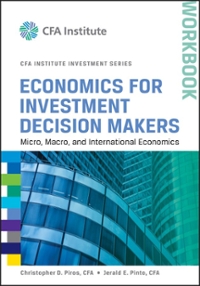Real and nominal rates interest Zane Perelli currently has $96 that he can spend today on socks costing $2.40 each. Alternatively, he could invest the $96 in a risk-free U.S. Treasury security that is expected to earn a 12% nominal rate of interest. The consensus forecast of leading economists is a 6% rate of inflation over the coming year a. How many socks can Zane purchase today? b. How much money will Zane have at the end of 1 year if he forgoes purchasing the socks today and invests his money instead? (Ignore taxes) c. How much would you expect the socks to cost at the end of 1 year in light of the expected inflation? d. Use your findings in parts b and e to determine how many socks (tractions are Ok Zane can purchase at the end of 1 year in percentage tems, how many more or fewer socks can Zane buy at the end of 1 year e. What is Zane's real rate of retum over the year? How is it related to the percentage change in Zane's buying power found in part d? Explain a. The number of socks Zane can purchase today is socks (Round to the nearest whole number ) b. The amount of money Zane will have at the end of 1 year if he forgoes purchasing the socks today is sm (Round to the nearest cent) c. The expected price of the socks at the end of 1 year in light of the expected inflation is $ (Round to the nearest cent) d. Using your findings in parts and e, the number of socks Zane can purchase at the end of 1 year is shirts (Round to four decimal places) in percentage terms, the more or lewer socks Zane can buy at the end of 1 year is 1% (Round to the nearest whole percent) e. Zane's rear rate of return over the year is % (Round to the nearest whole percent) How is the real rate of return related to the percentage change in Zane's buying power found in part d? (Select from the drop down menu.) The change in the number of socksts that can be purchased is equal to the since the portion of the nominal return for expected inflation is used to maintain the ability to purchase the same number of socks b and c to determine how many socks (fractions are OK) Zane can purchase at the end of 1 year. In percentage er socks can Zane buy at the end of 1 year? retum over the year? How is it related to the percentage change in Zane's buying power found in part d? Explain. e can purchase today is socks. (Round to the nearest whole number ) he will have at the end of 1 year if he forgoes purchasing the socks today is $ (Round to the nearest cent.) socks at the end of 1 year in light of the expected inflation is $(Round to the nearest cent) ts b and c, the number of socks Zane can purchase at the end of 1 year is shirts. (Round to four decimal re or fewer socks Zane can buy at the end of 1 year is 10%. (Round to the nearest whole percent) over the year is 1% (Round to the nearest whole percent) related to the percentage change in Zane's buying power found in part d? (Select from the drop-down menu.) of socksrts that can be purchased is equal to the Things since the portion of the nominal return for maintain the ability to purchase the same numbe real rate of return risk premium inflation premium nominal rate of return of the answer boxes








